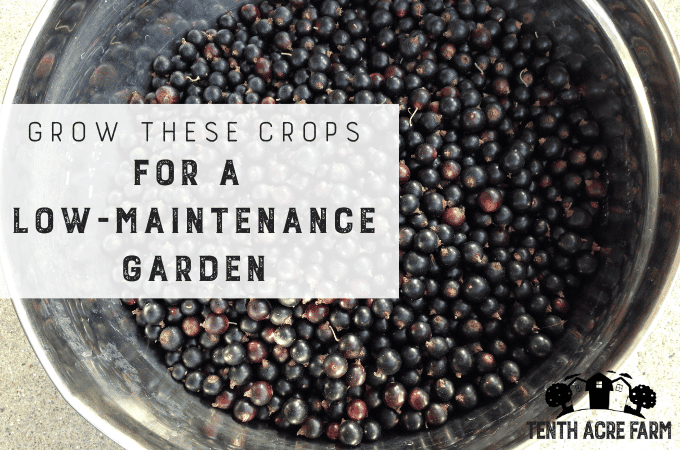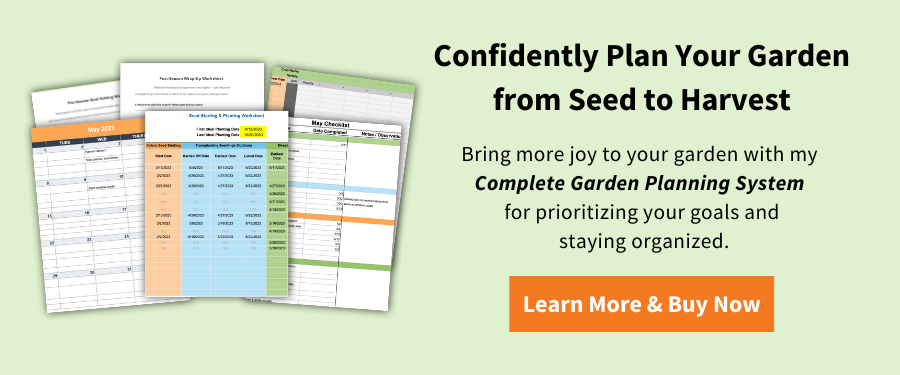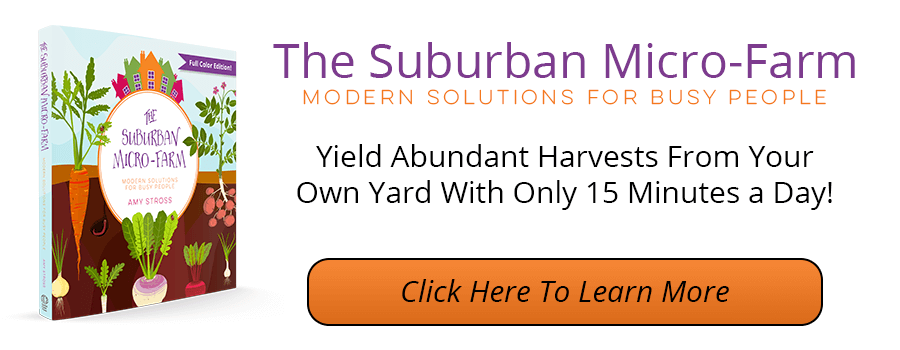Grow These Crops for a Low-Maintenance Garden
Do you need a low-maintenance garden to fit your lifestyle? Reap an abundant harvest with less work by growing these crops.


This page may contain affiliate links. Please read my disclosure for more info.
Do you go to your garden for a timeout from this fast-paced world? Gardening is a healthy hobby that can offer respite from the demands of modern life. However, it can also become a source of stress instead of solace. Like when the beloved garden is overtaken by weeds.
If you need a gardening strategy that matches your busy lifestyle, then you’re ready to focus on the following crops for a low-maintenance garden.
Annual Crops for the Low-Maintenance Garden
Let’s start with some vegetable crops that will help you fall in love with your garden again. Set-it-and-forget-it crops have a long season, don’t need a lot of babying, and are generally harvested all at one time.
The most ideal set-it-and-forget-it crops store well, too, which means you don’t have to process them right away.


Sweet potato harvest
Ideal Annual Crops: Garlic, Onions, Potatoes, Sweet Potatoes, Winter Squash
These crops can go into cold storage for up to 8 months or so. Because of their longevity, there is no need to worry if you can’t use them up right away.
Check out the book Root Cellaring for proper storage techniques for each type of fruit or vegetable. Or, get the plans to build your own root cellar.
Pretty Good Annual Crops: Asparagus*, Broccoli, Brussels sprouts, Cabbage, Leeks, Tomatoes**, Watermelon
These crops have a long season. Since they need some attention after harvesting, however, they aren’t as ideal as the list above. Broccoli, Brussels sprouts, cabbage, and leeks need refrigerated and have varying storage lengths.
Watermelon can remain in cold storage (whole) for 2-3 weeks. After that you’ll need to preserve them.
*Asparagus is a perennial rather than an annual. But since I’m talking about low-maintenance vegetables, I have to mention this easy-to-grow crop. Plant it once and get years of harvests! It’s in the pretty good category because it needs to be eaten or processed soon after harvesting.
**Tomatoes: Grow a determinate variety to get a bumper crop that is harvested all at once. Sit tomatoes out at room temperature for 2-3 days, then process after that. I like to freeze tomatoes in small batches until I have enough to make sauce. Try the San Marzano tomato—an heirloom that is excellent for making sauces.
Grow a garden that’s both productive and manageable with my Complete Garden Planning System, which includes practical tools for planning your season from seed to harvest.
Herbs for the Low-Maintenance Garden
If you’re looking for the ultimate low-maintenance crop that doesn’t mind being ignored completely, herbs are it.
Ideal Herbs: Chives, Oregano, Thyme
These herbs are perennial. Planted once, they come back every year without any work on your part. They are also easy to use in the kitchen. If you live in hardiness zones 7-10, you may also want to grow rosemary.
Fresh herbs are potent sources of nutrients, so adding just a tiny bit to meals can have a healthful effect. Try adding a handful of diced chives to mashed potatoes, fresh oregano leaves to pasta or pizza sauce, or fresh thyme leaves to rotisserie chicken or vegetable soup.
I love having these herbs right outside my kitchen door when I’m making dinner!
Prune them in late spring and again around August to about 5 inches of growth to keep them going indefinitely.
For more information on these herbs, see:


Chive blossoms
Pretty Good Herbs: Basil, Cilantro
Although these annual herbs need to be sown annually, I still enjoy growing them. That’s because they are just as beloved by the pollinators and beneficial insects as they are loved by me!
Stick basil sprigs (along with sprigs of oregano, rosemary, and thyme) in a glass of water on the kitchen counter. Simply change the water every couple of days. After a while, they will grow roots which can be planted back out in the garden!
Cilantro is one of my favorite flowers in the garden.
Are you looking for more strategies to grow food with the time you have? You’ll find loads of information just like this in my award-winning book, The Suburban Micro-Farm.
Fruits for the Low-Maintenance Garden
Fruit crops keep giving year after year with very little maintenance. Simply prune the trees or shrubs one or two times a year, and boost fertility once a year by adding compost or other organic matter.
Know your fruit’s harvest window and make sure you’re around for it!
Ideal Fruit Crops: Apples, Citrus Fruits, Grapes, Pears
The above fruits have a long storage life and require little processing after harvest.


Strawberries harvested from the garden
Pretty Good Fruit Crops: Berries, Pawpaws, Plums
Berries are prolific and don’t need much coaxing to grow (Hello, aronia berries!). However, they are highly perishable. Be ready to pop them in the freezer soon after harvesting.
If pawpaws or plums grow well in your area, they are reasonably low-maintenance choices. Find varieties of fruit that are (1) appropriate to your location, and (2) known to store well.
Cherries are my absolute favorite fruit, but I didn’t have the heart to list them here. That’s because cherries must be pitted before they can be frozen or dehydrated, and it is a fairly arduous, tedious process.
See my articles 5 Steps to Planting Fruit Trees and How to Build a Fruit Tree Guild for more information.
Tips for a Successful, Low-Maintenance Garden
Although this set-it-and-forget-it garden is sure to bring you loads of delicious satisfaction, here are a few things you can do to be more successful.
#1: Spend 15 minutes a day in the garden.
Think of this time as an observation period. If you follow my monthly garden planning suggestions or my 6 tips for success, you know that I am very protective of this 15 minutes a day.
Imagine spending 7 minutes before work (with coffee) and 8 minutes after work (with favorite happy hour beverage) walking through your garden. It’s not only relaxing, but it will help you stay connected to your garden even if you don’t have a lot of time to spend on it.
You may get to enjoy your apple tree in bloom or notice that the asparagus is ready to harvest earlier than expected. It ensures you don’t miss out on the essential reasons for having a garden!
This short daily visit helps you practice being in the garden, which is just as important as the doing!
#2: Mulch well.
If a low-maintenance garden is what you’re after, mulch the garden after planting to keep the weeds at bay.
Here are my tips for mulching.
#3: Stagger harvest windows.
As you decide what to plant in your low-maintenance garden, keep in mind each crop’s harvest window. It may not be a good idea to have multiple crops coming to harvest at the same time.
At the original Tenth Acre Farm, I planted black raspberries, cherry trees, currant bushes, and strawberries in my edible front yard. It was gloriously beautiful and productive, but all of these fruits come to harvest at the same time! It was quite the whirlwind to keep all the fruit from going to waste, and I don’t feel I was able to fully enjoy the gifts of each fruit.
Consider how you will process the bounty. Often it’s the processing that takes more time than the growing!
This of course depends on your circumstances. For some people, batching multiple harvests at once, with the rest of the year “off” from harvesting, may be preferable.
#4: Get it on the calendar.
Once you’ve decided what to plant, get essential information on the calendar so you don’t miss important garden events. Write down planting, harvesting, and pruning windows for each crop so you don’t miss out.
If calendars and checklists help you stay organized, then you’ll love the FREE bonus materials that come with the purchase of my book The Suburban Micro-Farm: Modern Solutions for Busy People. You’ll get a seedstarting & planting worksheet, monthly checklists and calendars, and a harvest log.
Summary
When times get busy, our happy place (garden) can turn into a source of stress. However, the crops in this article will help you to have a garden AND eat the harvest, too. The low-maintenance garden is within your reach!
What crops do you grow in the low-maintenance garden?
READ NEXT:









